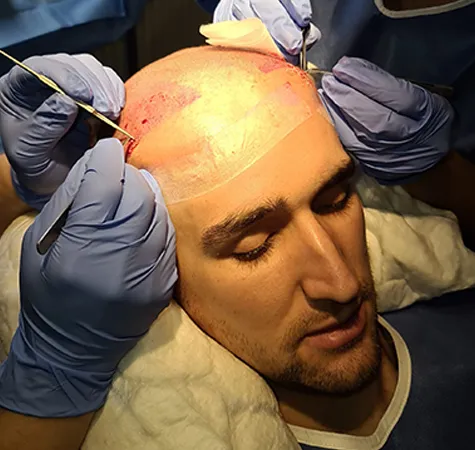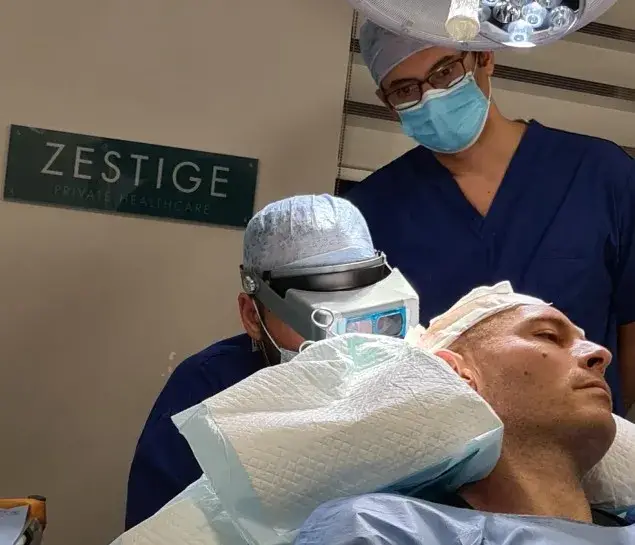In the modern world, where appearances can have a big impact on our lives, managing hair loss can be a difficult path. Globally, balding or thinning hair can have negative psychological and social effects on both men and women. Thankfully, medical technology advancements have brought about several hair loss treatments that can restore confidence levels in addition to hairlines. A minimally invasive process called Follicular Unit Excision (FUE) hair transplantation is one way to address this problem. It entails taking individual hair grafts from a donor location and transplanting them into places where hair is thinning or balding.
What is FUE Hair Transplant?
In a FUE hair transplant, individual hair follicles are surgically harvested from a donor area, usually the back or sides of the head, and are then implanted into the recipient area, which is experiencing hair loss. Unlike traditional methods, FUE does not involve the removal of a strip of scalp tissue, resulting in minimal scarring and a faster recovery time.
But how many hair grafts are needed to provide the intended effects?
It's important to first examine what FUE hair transplants entail to provide a more thorough understanding of the variables that may affect the computation.
Factors Affecting Graft Calculation
1. Balding Pattern
The extent and pattern of hair loss significantly affect the number of grafts needed for a successful transplant. Individuals with minor hair thinning may need fewer grafts, while those with advanced baldness or conditions like male pattern baldness may require more extensive coverage.
2. Donor Area Availability
The size, health, and availability of hair follicles in the donor area are crucial for graft calculation. Patients with a larger donor area have more flexibility in extracting grafts, potentially allowing for a greater number of grafts and more extensive coverage.
3. Hair Characteristics
Hair colour, thickness, and texture play a role in graft calculation. Thicker or curlier hair often provides better coverage and may require fewer grafts to achieve a denser look and feel, while finer hair may necessitate more grafts for adequate coverage.
4. Patient Goals
The desired outcome of the transplant influences graft calculation. Patients seeking a fuller head of hair will require more grafts, whereas those targeting specific areas of thinning or scars may need fewer grafts for targeted coverage. Understanding patient goals is essential for determining the appropriate number of grafts to achieve satisfactory results.

Calculating Grafts for Different Areas
The number of hair grafts needed for a successful hair transplant varies depending on factors such as the desired aesthetic outcome and the specific areas of the scalp requiring coverage. Typically, a single hair graft contains one to four hairs. For instance, a transplant targeting a small area of thinning may require around 500 to 1000 grafts hair transplant, while extensive baldness may necessitate 2000 to 3000 grafts or more for full coverage. The Norwood Scale aids in assessing the degree of hair loss, enabling specialists to estimate the appropriate number of grafts needed to achieve satisfactory results for each patient's unique condition.
It is crucial to consider the guidelines and requirements for each of these various areas when determining the total number of hair transplants needed.
The Norwood Scale was created to analyse patients' levels of hair loss to help with this.
This scale, which consists of seven progressive stages, evaluates each patient's present degree of hair loss, facilitating the process of correctly identifying the condition and estimating the approximate number of hair grafts needed.
The number of hair transplants needed will depend on the Norwood stage a patient fits into in addition to the location of the primary regions of hair loss:
Hairline and Temples
Typically, creating a natural-looking hairline and filling in the temples at the front of the head requires between 500 and 1800 hair grafts. This area is crucial for framing the face and restoring a youthful appearance.
Mid-Scalp
Moving further back, addressing hair loss in the middle of the head usually requires between 500 and 1500 hair grafts. This area contributes to overall hair density and coverage, enhancing the appearance of thickness and volume.
Crown (Vertex)
Restoring hair loss at the crown, located towards the back of the head, typically involves between 1000 and 2500 hair grafts. Filling in this area helps achieve a balanced and natural look from all angles.
Generally, achieving sufficient density across the front, mid-scalp, and crown regions of the head during an FUE hair transplant requires an average of 4000 hair grafts. However, depending on individual needs, up to 5000 grafts hair transplant may be utilised for comprehensive coverage and optimal results.
|
Norwood Scale |
Operation Needed? |
Location |
Number of Grafts |
|
1 |
No |
N/A |
0 |
|
2 |
Yes |
Temples |
500 – 800 |
|
2a |
Yes |
Centre |
500 – 800 |
|
3 |
Yes |
Front and temples |
1000 – 1700 |
|
3a |
Yes |
Front and crown |
Front: 1000 – 1700 Crown: 500 – 1000 |
|
4 |
Yes |
Front and crown |
Front: 1500 – 1800 Crown: 800 – 1200 |
|
4a |
Yes |
Front |
1700 – 2500 |
|
5 |
Yes |
Front and crown |
Front: 1800 – 2200 Crown: 1000 – 1500 |
|
5a |
Yes |
Front and crown |
2500 – 3200 |
|
6+ |
Yes |
Front and crown |
Front: 1800 – 2500 Crown: 1500 – 1700 |
Managing Expectations
Research indicates that FUE hair transplants in particular can successfully treat disorders like vitiligo and alopecia, as well as problems including burns, surgical scars, and cleft lip scars. Getting a hair transplant can have potentially life-changing effects.
Patients have to keep in mind a few important points and have reasonable expectations both before and after the procedure.
- Natural-Looking Results: FUE transplants prioritise creating a natural hairline over achieving a full head of hair, ultimately enhancing overall appearance and psychological well-being.
- Importance of Consultations: Initial consultations with a specialist play a vital role in determining the number of grafts needed and setting realistic expectations for the procedure.
- Possibility of Multiple Sessions: Full coverage often requires multiple transplant sessions, and immediate results may not always be attainable, highlighting the importance of patience throughout the process.
- Maintenance Requirements: FUE transplants do not prevent hair loss progression; hence, long-term maintenance with non-surgical treatments like finasteride or minoxidil is essential for preserving results.
- Patience is Key: Results of FUE transplants vary from person to person and may take several months to fully manifest. Thus, patience and adherence to post-transplant maintenance plans are crucial for optimal outcomes.
Conclusion
Understanding the factors that influence graft calculation is essential for achieving natural-looking results with FUE hair transplants. At Zestige Private Healthcare, we offer personalised treatment options and support throughout the hair restoration journey. Contact us today to learn more about our services and regain your confidence with a 1000 grafts hair transplant.





